Homemade Cauliflower Rice Recipe
Today I have a from-scratch homemade Cauliflower Rice recipe made with fresh cauliflower. It is a simple low-carb side dish with only 54 calories (and 3 net carbs) per serving. It is a kitchen basic to use instead of rice when you are following a low-calorie, grain-free, Whole30 or ketogenic diet.
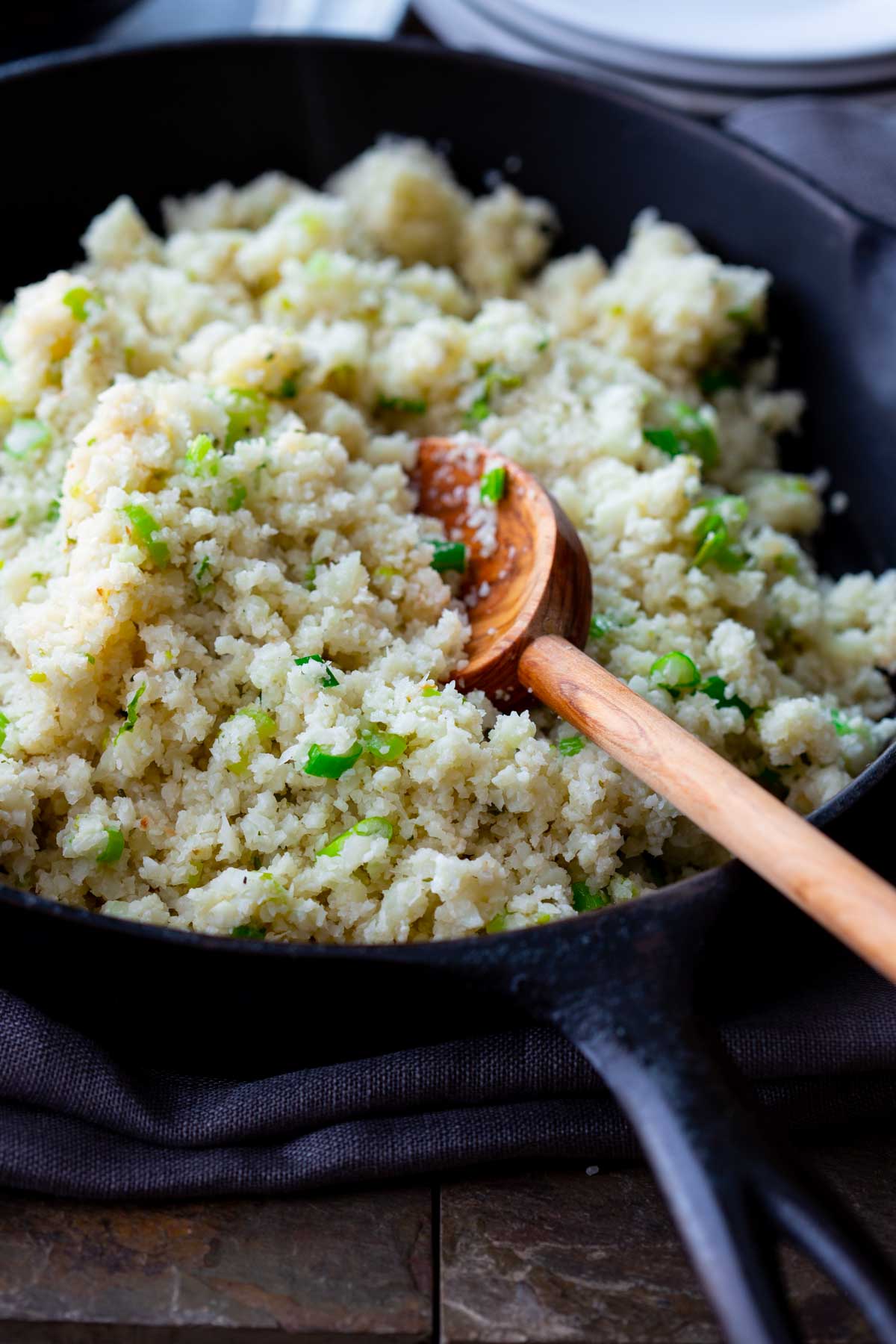
I shared this recipe for Cauliflower Rice on January 23, 2015. This post contains affiliate links.
Table of contents
Why This Recipe Works
Over the years I have collected dozens of healthy cauliflower recipes. I love cauliflower any which way! Back in 2015 I first shared this recipe for Cauliflower Rice, and it has become my go-to low-carb and low-calorie alternative for rice. I pair it with clean-eating stir fry, add it to keto soup, and use it for the base of low carb burger bowls to name a few favorite ways of using it!
Of course, since I first tried making cauliflower rice from scratch, the availability of fresh and frozen pre-chopped cauliflower rice has exploded across health food stores, specialty stores and most supermarkets too. I love the convenience of bagged cauliflower rice, but still prefer it from scratch. I think the texture is better and I like to add in some other veggies and seasoning to make it taste more like rice pilaf.
Ingredient Notes

- Cauliflower: You’ll need a whole head of cauliflower. Remove the green leaves and core and chop into chunks.
- Garlic: You’ll need one clove minced.
- Extra-virgin Olive Oil: You could also use butter or a neutral cooking oil. Better yet try roasted garlic oil for a boost of delicious garlic flavor.
- Broth: This is key to getting that clumpy rice-like texture! You can use a veggie broth to make this recipe vegan.
- Salt and Pepper: To season.
How To Make Cauliflower Rice Taste Good (Optional Ingredients)
- Celery: Celery is one of the optional ingredients that I add to my cauliflower rice to elevate the flavor and make it taste less like cauliflower and give it a homestyle flavor.
- Scallions or Green Onion: Scallion is optional, but I encourage you to add it because the taste of the allium mixed with the cooked riced cauliflower can help to cut any sulfurous flavors.
- Rosemary: I love the way rosemary tastes in cauliflower rice, but feel free to omit it depending on what you are pairing your cauli rice with. You can also sub in dried herbs in small amounts.
How to make Cauliflower Rice

Step 1: Rice The Cauliflower
To rice the cauliflower, cut it into chunks. Then pulse it in the food processor (right photo) in two to three batches (depending on the size of your head of cauliflower.) If the food processor is too full, you may end up with a few large pieces that remain intact. Simply, pull them out, dump the granulated “rice” into a bowl, and reprocess the large chunks.
Alternatively, you can rice the cauliflower by hand on a box grater (left photo.) Take caution not to get your fingers too close to the cutting surface. Using a protective glove can help!

Step 2: Saute Veggies and Aromatics
Heat the oil (or butter if using) in the skillet and add in the garlic to cook it in the oil before adding the riced cauliflower. If using the optional ingredients add in scallion whites, celery and rosemary. Saute until the garlic is fragrant, the scallion whites are translucent and the celery is starting to soften.
Step 3: Add Riced Cauliflower and Cook
Add the cauliflower, salt and pepper coating with the scallion mixture. Cook, stirring often until you start to notice browned cauliflower when you stir along the edges of the skillet, 3 to 4 minutes.
Add broth, stir to combine and increase heat to high. Cook stirring often until the cauliflower is cooked but not mushy, 3 to 4 minutes. Stir in scallion greens. Remove from the heat and serve.

Leftovers and Meal Prep
Storage: We love using cauliflower rice for meal prep and to reheat leftovers. Transfer the cooked and cooled cauliflower rice to glass storage containers and refrigerate up to 5 days.
Reheat: Reheat until steaming hot in the microwave for about 90 seconds on high per serving. Alternatively reheat on the stovetop in a saucepan with a little broth, stirring often over medium heat.
To Freeze
You can freeze this side dish after it is cooked but we think it is even better to rice the cauliflower, freeze it and then cook it from frozen.
To freeze it: Lay a sheet of parchment on a large, rimmed baking sheet. Spread the riced cauliflower out on the parchment and transfer the baking sheet to the freezer. Once frozen, break up large chunks and transfer the cauliflower rice to a resealable plastic freezer bag and freeze up to 1 month. Cook from frozen in step 3, adding a few additional minutes of timing to thaw it out.
What To Serve with Cauliflower Rice
Try it with lighter comfort foods like Chicken a la King, Chicken Paprika. I use it instead of rice to serve with stir-fried veggies and curries, and Chicken and Veggie Stir-fry. Use it in place of quinoa in these Chicken and Quinoa Bowls. If you skip the optional ingredients it is pretty neutral in flavor, and really a blank canvas for whatever you want to pair with it or add to it.

Frequently Asked Questions
This can happen if there is too much moisture in the pan and the cauliflower cooks through before the liquid evaporates. Make sure you are using a large skillet and try not to double the recipe.
We love adding cauliflower rice to soup but it can get soggy if it is overcooked. Add the raw riced cauliflower into the soup. Time it so that it is only cooking for the last three minutes. This will prevent it from getting soggy or mushy.
Just like heads of whole cauliflower that browns in storage, the same can happen with riced cauliflower. Store bought riced cauliflower in bags can get brown as it oxidizes. To prevent this, check your expiration dates before purchasing and use within a few days. Or follow our tips in this recipe to make rice your own cauliflower.
This is counterintuitive but to make cooked cauliflower rice have a thicker clumpy texture like cooked regular rice you should actually cut it more finely. I like the food processor for this. If you cut the cauliflower into more coarse grains they will not stick together. Also, it is key to use just a little liquid with the freshly chopped riced cauliflower to get it to clump up and thicken. This softens the cauliflower. Note that it is hard to thicken frozen cauliflower rice as it is usually larger “grains” so it is important not to add too much excess moisture to it.
Yes! Cauliflower is low in calories and high in vitamins and nutrients. This cauliflower rice recipe has only about a third of the calories of the same volume of white rice. Consider swapping out lower-calorie sides that fill up your plate and belly with fiber and volume.
More Low Carb Cauliflower Recipes
More Favorite Low-Carb Recipes
Thanks so much for reading! If you are new here, you may want to sign up for my email newsletter to get a free weekly menu plan and the latest recipes right to your inbox. If you make this recipe, please come back and leave a star rating and review. I would love to hear what you thought!
Happy Cooking! ~Katie
Print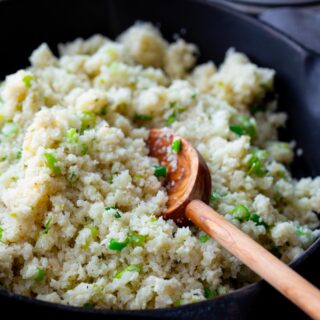
Cauliflower Rice Recipe
- Total Time: 20 minutes
- Yield: 5 cups 1x
- Diet: Diabetic
Description
Cauliflower rice is a plain and simple low carb and keto vegetable side dish and rice alternative. It’s ready in 20 minutes or less. It can be made Vegan and Whole30 compliant.
Ingredients
- 1 head cauliflower, core and leaves removed, cut into big chunks
- 1 tablespoon plus 2 teaspoons extra-virgin olive oil
- 4 scallions, sliced white and green parts divided
- 1 clove garlic minced
- 1/2 cup finely chopped celery
- 1 teaspoon chopped fresh rosemary
- 1/2 teaspoon salt
- 1/4 teaspoon ground pepper, preferably white pepper
- 3/4 cup reduced sodium chicken (or Imagine no-chicken broth for Vegan option)
Instructions
- Place about 1/3 of the cauliflower in a food process fitted with steel blade attachment. Process until the cauliflower looks like tiny crumbs, 20 to 40 seconds. Transfer the processed cauliflower to a bowl, and repeat with the remaining cauliflower in two more batches.
- Heat oil in a 9-inch cast-iron skillet over medium-high heat. Add scallion whites, garlic, celery and rosemary and cook, stirring often until the scallion whites are starting to soften and become translucent, and the garlic is just starting to brown, 1 ½ to 3 minutes.
- Gradually stir in cauliflower, salt and pepper coating with the scallion mixture. Cook, stirring often until you start to notice browned cauliflower when you stir along the edges of the skillet, 3 to 4 minutes. Add broth, stir to combine and increase heat to high. Cook stirring often until the cauliflower is cooked but not mushy, 3 to 4 minutes. Stir in scallion greens. Remove from the heat and serve.
Notes
Storage: We love using cauliflower rice for meal prep and to reheat leftovers. Transfer the cooked and cooled cauliflower rice to glass storage containers and refrigerate up to 5 days.
Reheat: Reheat until steaming hot in the microwave for about 90 seconds on high per serving. Alternatively reheat on the stovetop in a saucepan with a little broth, stirring often over medium heat.
- Prep Time: 20 minutes
- Cook Time: 10 minutes
- Category: Side Dish
- Method: Stove Top
- Cuisine: American
Nutrition
- Serving Size: 2/3 cup
- Calories: 54 calories
- Sugar: 1.5 g
- Sodium: 260 mg
- Fat: 3 grams fat
- Saturated Fat: 0 g sat
- Carbohydrates: 6 g
- Fiber: 3 g
- Protein: 2 g

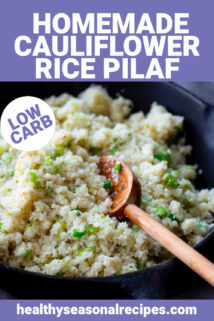


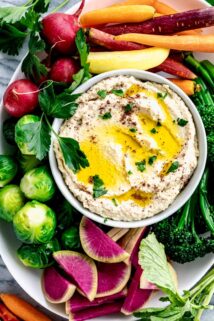
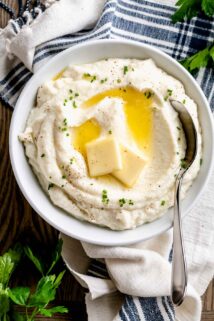
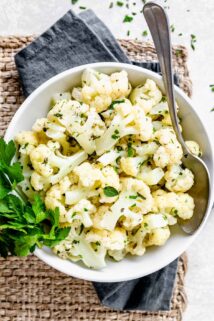
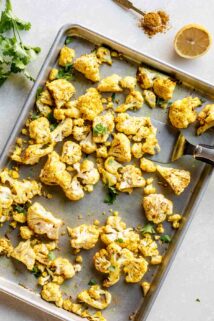
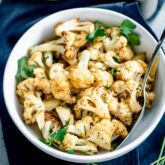




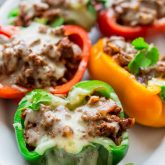

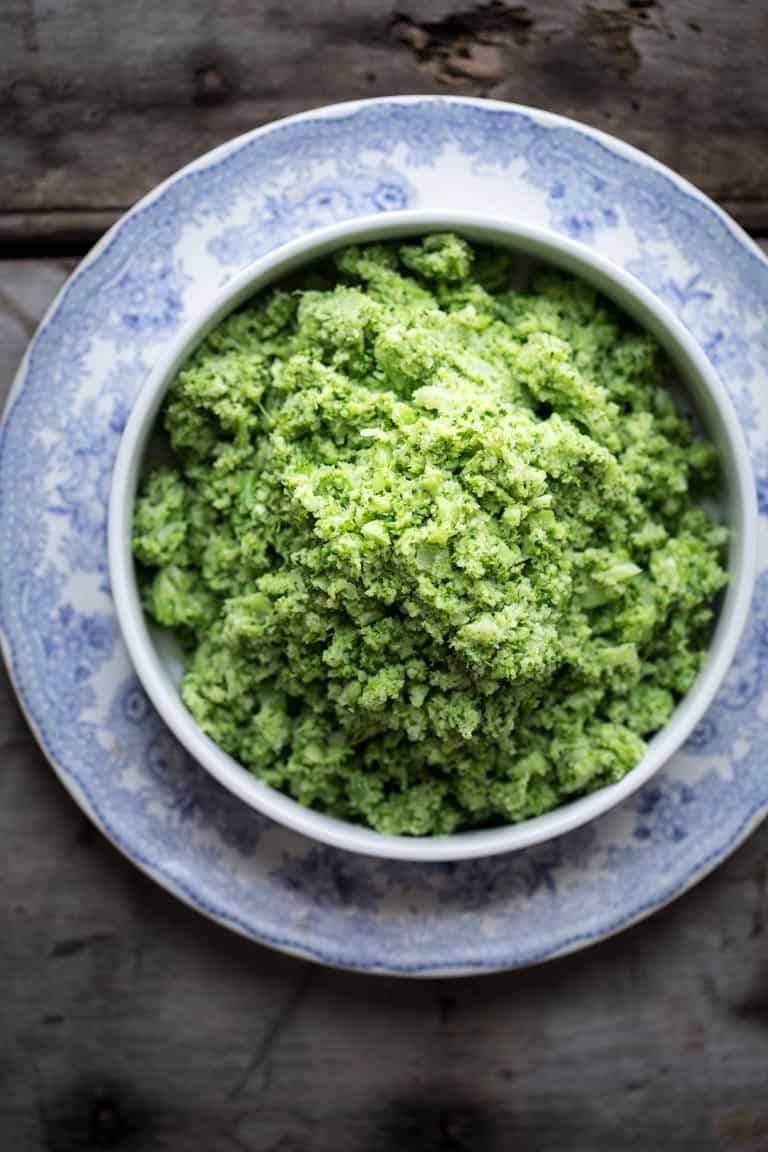
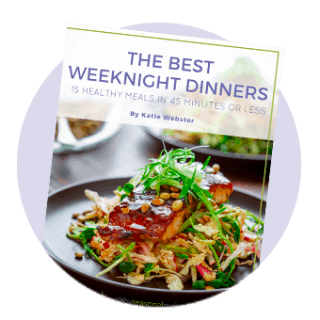

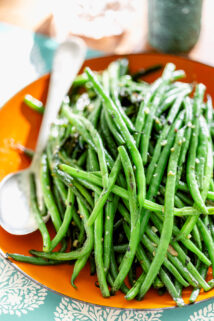

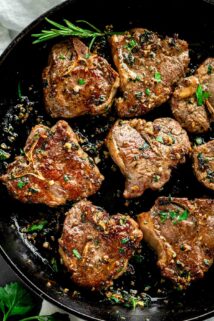
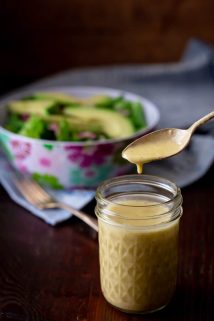

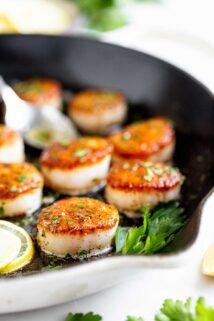
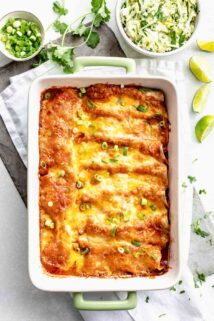
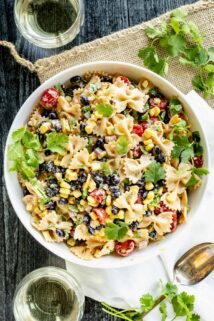

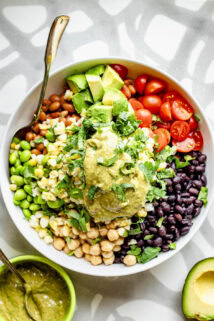
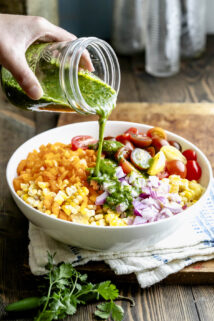
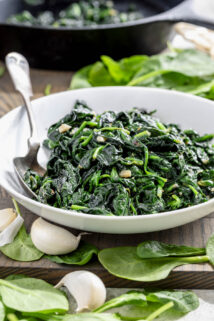
This was a seriously easy and foolproof recipe. Made it for company and they asked for the recipe, it really tasted so much like rice! Will definitely be making this again!
Thank you so much for your lovely comment, Erin!
Cauliflower rice is one of my favorite side dishes. This version looks delicious. I’m adding this recipe to my meal list this week.
I am so happy to hear it!
10/10 my beef with cauliflower rice is that it’s always so mushy but this recipe NAILED it. I’ll definitely be making this again!
Honestly, I’ve never tried cauliflower rice, but I will try out your recipe because it looks so fluffy and delicious!
I LOVE cauliflower rice and never thought about adding celery before. it adds a really nice extra crunch!
I love the name “Judy Tahini”!!!! She is super cute!
My daughter named our pup “Oliver” – just so he had a “human” name too! And we used to freeze toys and give them too him – seemed to alleviate his biting-everything-in-sight issues!
Btw, I’ve yet to make cauli-rice so this recipe is much appreciated! Thank You!!!
I just tried making Cauliflower Rice for my family earlier this week and it was a huge hit! I used a slightly different flavor profile that went with herbed lamb skewers. I’ll have to give your recipe a try sometime. I think it would be great with roasted chicken, or carrots, or green beans. Yum!
I do think Cauliflower Rice needs a little something added to make it taste good, but you nailed it!
Looking at Judy T’s photos was an awesome way to start my Saturday morning, Katie! We’re huge dog lovers and we’re getting another puppy in a couple of months. I’m readying myself for the hysteria of having a new puppy and two adult dogs! It’s so worth it though. We eat cauliflower almost every week and I’ve never made it in the rice form. Definitely trying this recipe this week!
This looks awesome! I’ve tried cauliflower rice before, in Fried Rice, and it is excellent! Tossed in a skillet with a little soy sauce and spices, and some mixed veggies and egg. Even my husband really enjoyed it. I’ve never had it as a simple side like this, though, and I love your suggestions for flavor.
Your new puppy is absolutely adorable. Just what I needed to get me through this friday!
I love the idea of using the cauliflower rice to make fried rice. Great suggestion Barbara.
What an adorable puppy! I’m one of those crazy people who isn’t fond of rice, so I make cauliflower rice instead. This looks terrific!
Glad to hear it. I am glad I finally caught on. It is a great substitute, and far fewer calories too!
I found myself wondering why I waited so long to try cauliflower rice too! Glad I’m not the only one 🙂 Love how simple and delicious this side is – your version sounds especially yummy!
Thank you for the inspiration Elizabeth! Happy cooking my dear. 🙂